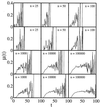Explaining mortality rate plateaus
- PMID: 11752476
- PMCID: PMC65038
- DOI: 10.1073/pnas.261228098
Explaining mortality rate plateaus
Abstract
We propose a stochastic model of aging to explain deviations from exponential growth in mortality rates commonly observed in empirical studies. Mortality rate plateaus are explained as a generic consequence of considering death in terms of first passage times for processes undergoing a random walk with drift. Simulations of populations with age-dependent distributions of viabilities agree with a wide array of experimental results. The influence of cohort size is well accounted for by the stochastic nature of the model.
Figures




References
-
- Finch C. Longevity, Senescence, and the Genome. Chicago: Univ. of Chicago Press; 1990.
-
- Wachter K, Finch C, editors. Between Zeus and the Salmon: The Biodemography of Longevity. Washington, DC: Natl. Acad. Press; 1997. - PubMed
-
- Johnson F, Sinclair D, Guarente L. Cell. 1999;96:291–302. - PubMed
-
- Gompertz B. Philos Trans R Soc London A. 1825;115:513–525.
-
- Carey J, Liedo P, Orozco D, Vaupel J. Science. 1992;258:457–461. - PubMed
Publication types
MeSH terms
LinkOut - more resources
Full Text Sources

